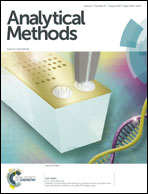Determination of ketoacids in drinking water by DNPH derivatization and LC-ESI-MS/MS†
Abstract
A quantitative method for determination of ketoacids, including glyoxylic acid, pyruvic acid and ketomalonic acid, in ozonated drinking water was developed by using 2,4-dinitrophenylhydrazine (DNPH) derivatization combined with liquid chromatography-electrospray mass spectrometry analysis. The optimized derivatization conditions were obtained under a molar ratio of DNPH and the total reactive groups at 150, derivatization temperature at 40 °C and derivatization time at 1 h. The method detection limits were 0.5 μg L−1 for glyoxylic acid, 0.3 μg L−1 for pyruvic acid and 0.2 μg L−1 for ketomalonic acid, which were similar to those of the pentafluorobenzylhydroxylamine-gas chromatography-electron capture detection method. The mean recoveries of glyoxylic acid and pyruvic acid were in the range of 94–109%, whereas the inorganic matrix effect reduced the average recovery of ketomalonic acid to 65%. Due to this matrix effect, it is suggested the standard addition method be applied to determination of ketomalonic acid. Finally, the method was field tested by determining ketoacids in water samples collected from a drinking water treatment plant consisting of ozone and biologically active carbon (BAC) processes. The analytical results indicated that ketoacids were formed during ozonation and near completely removed through the subsequent BAC process.


 Please wait while we load your content...
Please wait while we load your content...